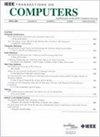双快速通道缓存:组织环形赛道工作作为L1缓存
IF 3.8
2区 计算机科学
Q2 COMPUTER SCIENCE, HARDWARE & ARCHITECTURE
引用次数: 0
摘要
静态随机存取存储器(SRAM)是最快的存储器技术,是处理器流水线中实现一级(L1)缓存的常用设计选择,其中速度是必须满足的关键设计问题。相反,与动态RAM等其他技术相比,该技术提供的密度要低得多,将现代处理器的L1缓存大小限制在几十KB。本文探讨了在L1缓存中使用较慢但更密集的域壁内存(DWM)技术。这种技术提供了较慢的访问时间,因为它将多个比特顺序排列在磁跑道上。为了访问这些位,需要对它们进行移位,以便将它们置于标题下。1位移位通常需要一个处理器周期,这可能会严重损害应用程序性能,使这种工作行为不适合L1缓存。基于缓存利用的局部性(时间和空间)原则,本工作提出了双快速通道缓存(Dual Fast-Track Cache, FTC)设计,这是一种组织一组赛道来构建集关联缓存的新方法。与传统的SRAM缓存相比,Dual FTC将存储容量提高了5倍,同时产生最小的移动开销,从而使其成为L1缓存实现的实用且吸引人的解决方案。实验结果表明,所设计的缓存组织在L1数据缓存命中率和L1指令缓存命中率分别为78%和86%时与SRAM缓存一样快(即不需要移位)。因此,由于L1缓存容量更大,在相同的硅面积下获得了显著的系统性能提升(平均提升22%)。本文章由计算机程序翻译,如有差异,请以英文原文为准。
Dual Fast-Track Cache: Organizing Ring-Shaped Racetracks to Work as L1 Caches
Static Random-Access Memory (SRAM) is the fastest memory technology and has been the common design choice for implementing first-level (L1) caches in the processor pipeline, where speed is a key design issue that must be fulfilled. On the contrary, this technology offers much lower density compared to other technologies like Dynamic RAM, limiting L1 cache sizes of modern processors to a few tens of KB. This paper explores the use of slower but denser Domain Wall Memory (DWM) technology for L1 caches. This technology provides slow access times since it arranges multiple bits sequentially in a magnetic racetrack. To access these bits, they need to be shifted in order to place them under a header. A 1-bit shift usually takes one processor cycle, which can significantly hurt the application performance, making this working behavior inappropriate for L1 caches. Based on the locality (temporal and spatial) principles exploited by caches, this work proposes the Dual Fast-Track Cache (Dual FTC) design, a new approach to organizing a set of racetracks to build set-associative caches. Compared to a conventional SRAM cache, Dual FTC enhances storage capacity by 5× while incurring minimal shifting overhead, thereby rendering it a practical and appealing solution for L1 cache implementations. Experimental results show that the devised cache organization is as fast as an SRAM cache for 78% and 86% of the L1 data cache hits and L1 instruction cache hits, respectively (i.e., no shift is required). Consequently, due to the larger L1 cache capacities, significant system performance gains (by 22% on average) are obtained under the same silicon area.
求助全文
通过发布文献求助,成功后即可免费获取论文全文。
去求助
来源期刊

IEEE Transactions on Computers
工程技术-工程:电子与电气
CiteScore
6.60
自引率
5.40%
发文量
199
审稿时长
6.0 months
期刊介绍:
The IEEE Transactions on Computers is a monthly publication with a wide distribution to researchers, developers, technical managers, and educators in the computer field. It publishes papers on research in areas of current interest to the readers. These areas include, but are not limited to, the following: a) computer organizations and architectures; b) operating systems, software systems, and communication protocols; c) real-time systems and embedded systems; d) digital devices, computer components, and interconnection networks; e) specification, design, prototyping, and testing methods and tools; f) performance, fault tolerance, reliability, security, and testability; g) case studies and experimental and theoretical evaluations; and h) new and important applications and trends.
 求助内容:
求助内容: 应助结果提醒方式:
应助结果提醒方式:


